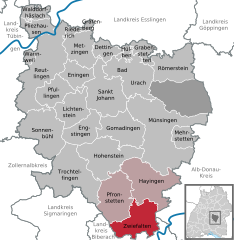
The Swabian Jura, sometimes also named Swabian Alps in English, is a mountain range in Baden-Württemberg, Germany, extending 220 km (140 mi) from southwest to northeast and 40 to 70 km in width. It is named after the region of Swabia. It is part of the Table Jura.

Sigmaringen is a town in southern Germany, in the state of Baden-Württemberg. Situated on the upper Danube, it is the capital of the Sigmaringen district.
Reutlingen, nicknamed "The Gate to the Swabian Alb", is a Landkreis (district) in the middle of Baden-Württemberg, Germany. The former free imperial city reached the limit of 100,000 residents in 1989. It is the ninth-largest city in Baden-Württemberg. Reutlingen district's neighboring districts are Esslingen, Göppingen, Alb-Donau, Biberach, Sigmaringen, Zollernalbkreis, Tübingen and Böblingen.

Weingarten is a town with a population of 25,000 in Württemberg, in the District of Ravensburg, in the valley of the Schussen River. Together with the southern neighbour cities of Ravensburg and Friedrichshafen on Lake Constance (Bodensee), it forms one of 14 medium-sized infrastructural centres in Baden-Württemberg. The town is seat of the University of Applied Sciences of Ravensburg-Weingarten and of the Teachers' College of Weingarten.

Reutlingen : is a city in Baden-Württemberg, Germany. It is the capital of the eponymous district of Reutlingen. As of June 2018, it has an estimated population of 116,456. Reutlingen has a university of applied sciences, which was founded in 1855, originally as a weavers' school. Today, Reutlingen is home to an established textile industry and also houses machinery, leather goods and steel manufacturing facilities. It has the narrowest street in the world, Spreuerhofstraße.

Riedlingen is a town in the district (Kreis) of Biberach, Baden-Württemberg, in the south-west of Germany. It is one of the destinations of the Upper Swabian Baroque Route. Riedlingen has approximately 11,000 inhabitants.
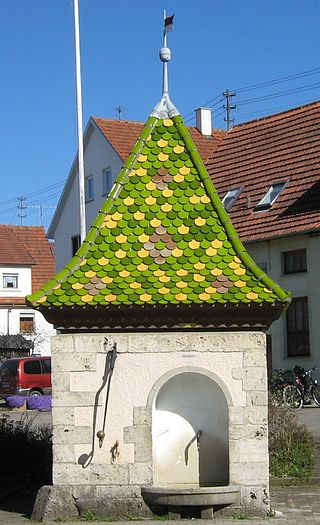
Engstingen is a municipality in the Tübingen administrative region (Regierungsbezirk) in Baden-Württemberg, Germany. It lies in the Swabian Jura (plateau), about 15 kilometres (9.3 mi) south of Reutlingen.

Zwiefalten Abbey is a former Benedictine monastery situated at Zwiefalten near Reutlingen in Baden-Württemberg in Germany. Zwiefalten is on the Upper Swabian Baroque Route.

Upper Swabia is a region in Germany in the federal states of Baden-Württemberg and Bavaria. The name refers to the area between the Swabian Jura, Lake Constance and the Lech. Its counterpart is Lower Swabia (Niederschwaben), the region around Heilbronn.

Pfullingen is a town in the district of Reutlingen, Baden-Württemberg, Germany. It is situated 3 km southeast of Reutlingen at the foot of the Swabian Alb. With its almost 20,000 inhabitants it is famous for its Handball team, which in 2006 had to file for bankruptcy, the Schönbergturm and the People mover.
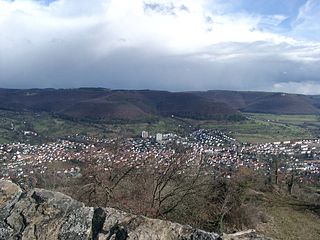
Eningen is a municipality in the district of Reutlingen, Baden-Württemberg, Germany. It is situated at the foot of the Swabian Alps and near the big cities of Reutlingen and Stuttgart. Although it has a considerable population with around 10,800 inhabitants, its structure is considered to be more the one of a village. The most important annual events include the Dorffest, the village festivity, the Krämerfest, and the Weihnachtsmarkt. Eningen is surrounded by free-standing hills of the Achalm and the Swabian Alps with landscape full of dark green forests and cliffs. This makes volksmarching, hiking and biking popular.
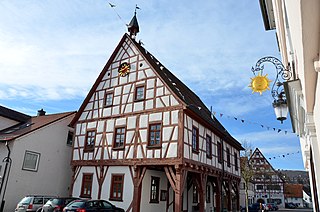
Schelklingen is a town in the district of Alb-Donau in Baden-Württemberg in Germany. It is situated 10 km north of Ehingen, and 20 km west of Ulm. Schelklingen and 82% of its territory form part of the Swabian Jura Biosphere Reserve.

Gomaringen is a municipality located about 10 km south of Tübingen in the German state of Baden-Württemberg.
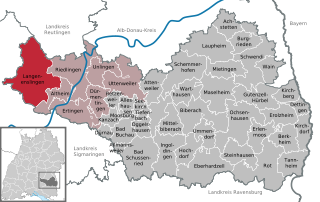
Langenenslingen is a municipality in the district of Biberach in Baden-Württemberg in Germany. It has a population close to 3,500.

Pliezhausen is a municipality in the district of Reutlingen in Baden-Württemberg in Germany.

Sonnenbühl is a municipality in the district of Reutlingen, state of Baden-Württemberg, Germany.

St. Johann is a municipality in the district of Reutlingen in Baden-Württemberg in Germany. The seat of the municipal administration is Würtingen. Large parts of the area (44.2%) of St. Johann are part of the UNESCO Biosphere Swabian Alb.

Achalm Castle is a ruined castle located above the towns of Reutlingen and Pfullingen in Baden-Württemberg, Germany. Situated on the top of a hill at the edge of the Swabian Alb the ruins of the 11th-century castle are topped by a look-out tower from 1838.

The Zwiefalter Aach or Zwiefalter Ach is a river in Reutlingen district and Biberach district in Baden-Württemberg, Germany. It is approximately 9 kilometres long and is a tributary of the Danube near Zwiefalten. The river is known for the Wimsener Höhle.

The Wimsener Höhle is Germany´s only water cave, which can be visited by boat. It is located in the municipal area of Hayingen on the Swabian Alb, about three kilometers north of Zwiefalten.

